
The seventh USS Washington (ACR-11/CA-11/IX-39), also referred to as "Armored Cruiser No. 11", and later renamed Seattle and reclassified CA-11 and IX-39, was a United States Navy Tennessee-class armored cruiser. She was laid down on 23 September 1903 at Camden, New Jersey, by the New York Shipbuilding Corporation, launched on 18 March 1905, sponsored by Miss Helen Stewart Wilson, daughter of United States Senator John L. Wilson of Washington state, and commissioned at the Philadelphia Navy Yard on 7 August 1906, Captain James D. Adams in command.

USS Galena was a wooden-hulled broadside ironclad built for the United States Navy during the American Civil War. The ship was initially assigned to the North Atlantic Blockading Squadron and supported Union forces during the Peninsula Campaign in 1862. She was damaged during the Battle of Drewry's Bluff because her armor was too thin to prevent Confederate shots from penetrating. Widely regarded as a failure, Galena was reconstructed without most of her armor in 1863 and transferred to the West Gulf Blockading Squadron in 1864. The ship participated in the Battle of Mobile Bay and the subsequent Siege of Fort Morgan in August. She was briefly transferred to the East Gulf Blockading Squadron in September before she was sent to Philadelphia, Pennsylvania for repairs in November.
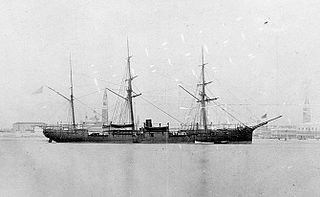
The second USS Ticonderoga was a 2526-ton Lackawanna-class screw sloop-of-war laid down by the New York Navy Yard in 1861; launched on 16 October 1862; sponsored by Miss Katherine Heaton Offley; and commissioned at New York on 12 May 1863, Commodore J. L. Lardner in command.

The first USS Rhode Island was a side-wheel steamer in the United States Navy, commissioned in 1861.

John Lorimer Worden was a U.S. Navy officer in the American Civil War, who took part in the Battle of Hampton Roads, the first-ever engagement between ironclad steamships at Hampton Roads, Virginia, on 9 March 1862.

The first USS Pawnee was a sloop-of-war in the United States Navy during the American Civil War. She was named for the Pawnee Indian tribe.
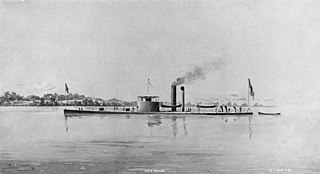
The first Passaic was a single turreted, coastal monitor purchased by the United States Navy for service during the American Civil War.
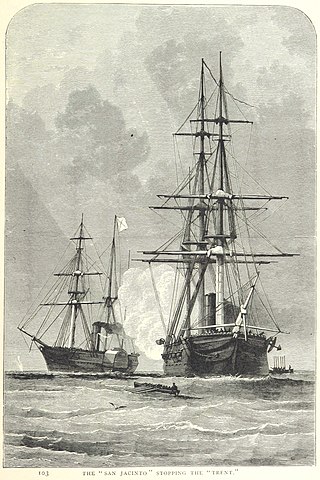
The first USS San Jacinto was an early screw frigate in the United States Navy during the mid-19th century. She was named for the San Jacinto River, site of the Battle of San Jacinto during the Texas Revolution. She is perhaps best known for her role in the Trent Affair of 1861.

|} The first USS Tuscarora was a Mohican-class sloop of war in the United States Navy during the American Civil War. Tuscarora was laid down on 27 June 1861 at Philadelphia, Pennsylvania, by Merrick & Sons; launched on 24 August 1861; sponsored by Miss Margaret Lardner; and commissioned on 5 December 1861, Commander Tunis A. M. Craven in command.

The first USS Juniata was a sloop of war in the United States Navy during the American Civil War.

The first USS Jamestown was a sloop-of-war in the United States Navy during the Mexican–American War and the American Civil War.

The first USS Swatara was a wooden, screw sloop in the United States Navy. She was named for Swatara Creek in Pennsylvania.
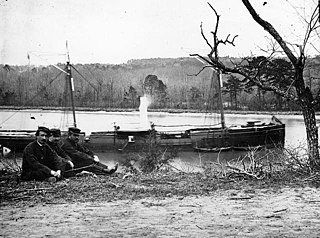
USS Kansas was a gunboat constructed for the Union Navy during the middle of the American Civil War. She was outfitted with heavy guns and assigned to the Union blockade of the waterways of the Confederate States of America. She was the first U.S. Navy ship to be named Kansas and was the first of a class of 836-ton screw steam gunboats. At war's end, she continued serving her country by performing survey work and defending American interests in Cuba until sold in 1883.

The second USS Amphitrite—the lead ship in her class of iron-hulled, twin-screw monitors—was laid down, on June 23, 1874, by order of President Ulysses S. Grant's Secretary of Navy George M. Robeson at Wilmington, Delaware, by the Harlan and Hollingsworth yard; launched on 7 June 1883; sponsored by Miss Nellie Benson, the daughter of a Harlan and Hollingsworth official; and commissioned at the Norfolk Navy Yard, Portsmouth, Virginia, on 23 April 1895, Captain William C. Wise in command.
Commodore Reigert Bolivar Lowry was an officer of the United States Navy.

USS Topeka (PG-35) was a gunboat of the United States Navy.
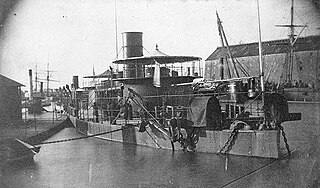
The Miantonomoh class consisted of four monitors built for the Union Navy during the U.S. Civil War, but only one ship was completed early enough to participate in the war. They were broken up in 1874–1875.

USS Huron was an iron-hulled gunboat of the United States Navy. She was a screw steamer with full-rig auxiliary sail, built by John Roach & Sons in Chester, Pennsylvania from 1873 to 1875 and commissioned at Philadelphia Navy Yard on 15 November 1875.
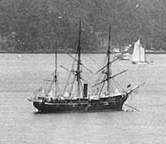
As part of the Secretary of the Navy George M. Robeson's plans to overhaul and modernize ships of the Navy, the first USS Swatara was taken to the New York Navy Yard in 1872, ostensibly for "repairs". In fact, the "repairs" constituted construction of a new ship, for Swatara was given a new hull and unused machinery which had been in storage since 1865. Embodying only certain fittings and equipment from the first ship, the second Swatara was launched on 17 September 1873 at the New York Navy Yard and commissioned on 11 May 1874, Capt. Ralph Chandler in command.

John Cummings Howell was an officer in the United States Navy during the American Civil War. He rose to the rank of rear admiral and late in his career was commander-in-chief of the North Atlantic Squadron and then of the European Squadron.


















